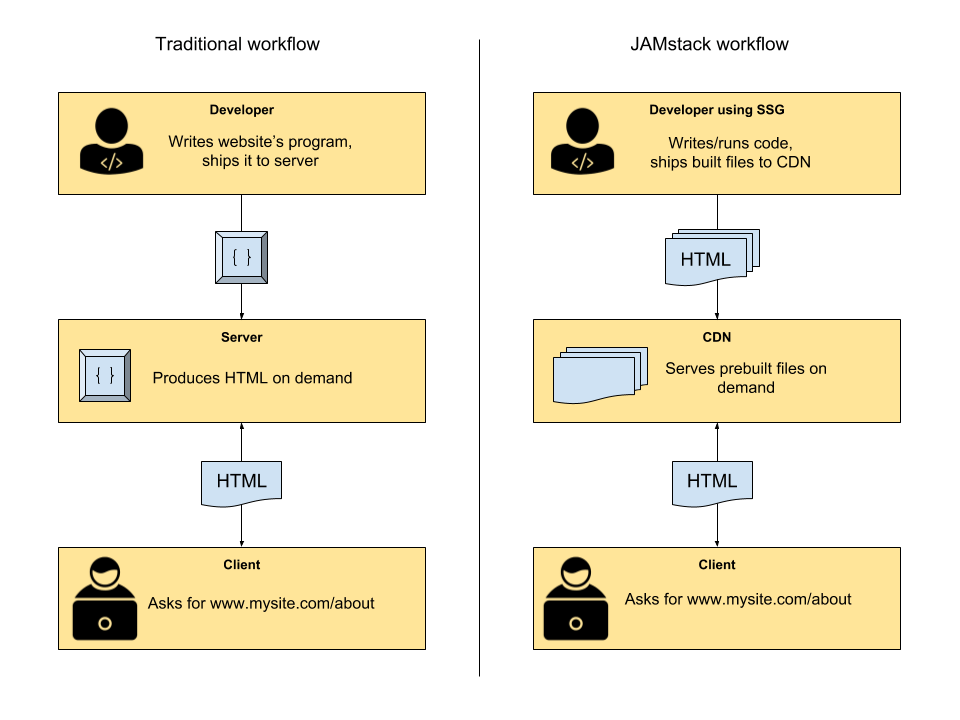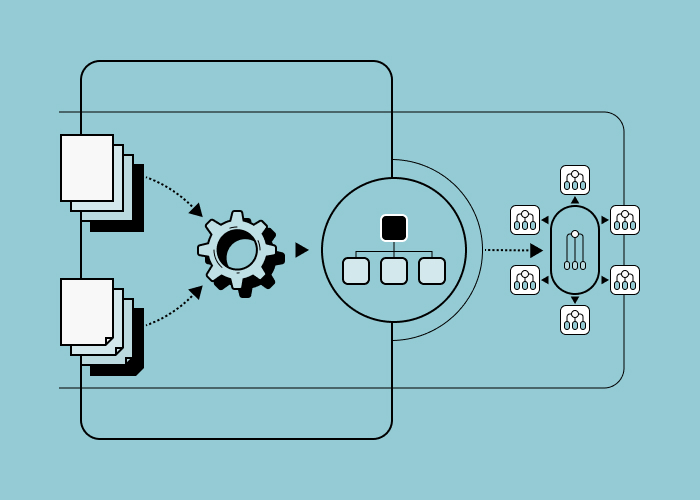Despite the ceaseless popularity of CMS (content management systems), we cannot deem the approach to implementing web resources with their help flawless. They are pretty convenient to work with, most solutions have a steep learning curve, and website deployment usually turns out quite affordable.
But the results of employing such platforms can be cumbersome. Dynamic websites that are able to handle huge traffic inflows and hacker attacks cannot boast high loading speed and require some integral backend support.
Considering all that, we can now shift focus onto a recently appeared in the global web development community, principally different way to build sites called JAMStack. Let’s take a more detailed look at the concept.
WTF is JAMStack?

What do devs understand under the JAMStack approach? It is, basically, a web technology stack that consists of:
- “J” (JavaScript) - a coding language for user-side rendering;
- “A” (API) - application programming interface that allows integrating additional server-side features;
- “M” (Markup) - the foundation of a website, its basic carcass.
What do we get as a result of such an approach? We get websites that aren’t “attached” to a single web server but are based on the fully-featured CDN. All the cache is saved on the client side, which boosts page loading speed dramatically. All versions of the web project are also stored in Git. That’s why even if some server goes out of order, any client repository can be copied to another server to resume the website performance.
When Should JAM Web Technology Stack Replace Traditional Workflow?
In fact, we can highlight a whole extensive list of reasons why you should start practicing JAMStack. To keep it all concise, however, you should ultimately go for this approach if:

- Your dynamic website is difficult & costly to scale;
- Your dynamic website isn’t easily synchronized with third-party solutions (ERP, CRM systems);
- You feel that your CMS restricts your flexibility when working on the UX;
- You realize that CMS isn’t the safest option out there;
- You don’t want page loading speed to be directly dependent on the web server;
- You are experiencing issues with a mobile version of your dynamic website;
- You want to work with modern technologies (like React, Vue, etc.);
- You don’t wish to bother with SEO due to server-side flaws;
- You’d like to connect your backend to the cloud.

Deciding to go for static website building and JAM architecture, you can efficiently avoid all the above and more related issues.
Principal Differences Between Traditional Dynamic Sites & JAM Solutions
Now, let’s go deeper into the details and find out how the traditional web development approach differs from the JAMStack approach in practice. Thus, the traditional workflow implies that all the developer’s work is, to some extent, concentrated around the hosting connection.
Everything becomes complicated due to excessive connections resulting from requests to a web server, database, CMS, etc. Additionally, the content may be refreshed via an outdated FTP data transfer protocol, reducing the overall reliability and speed of the website.
In terms of JAMStack, everything is much simpler. First off, you don’t have to depend on the hosting, which means that developers get more flexibility when creating every other JAM component.
Secondly, resources based on this approach better fit globally-distributed target audiences with high-speed data refreshing reached due to the CDN specifics. Lastly, advanced static generators are used to build sites, which are a step ahead of the need to employ centralized version control systems.
Do CMS Platforms Become Obsolete?
Coming from the above-said, we cannot say for sure that CMS solutions used to build dynamic websites aren’t relevant anymore. They are still good for implementing simple projects with low or medium performance requirements.
Moreover, they make a lot of things simpler for software engineers - all you need to do to launch a web resource is code, configure your CMS, connect the frontend to the DBMS, and customize it via the admin cabinet.
With all that in mind, a couple of web developers can be enough to implement simple dynamic resources, saving the client’s budget significantly.
That is all fine and dandy, but, nonetheless, employing JAMStack, you are looking at protecting your future web resource from:
- Hacker attack flaws that are characteristic to the vast majority of CMS solutions;
- DDoS attacks, which is an inevitable destiny of websites that become suddenly pressured with a huge inflow of traffic;
- Slow refreshed content loading speed;
- Excessive need in constant server-side tech support, which is expensive & requires a respective team of experts.
As such, it is safe to say that the web development stack that is based on JAM can save lots of client money in a long-term perspective.
How Does JAMStack Solve Issues of Other New Website Technologies?
Let’s take a look through some practical aspects of implementing a JAM programming stack which clearly indicate the absence of many issues that most dynamic website creators come across.
Thus, when you deploy a static resource, you can integrate with practically any available service where data can be stored. There are plenty of such solutions nowadays (like JAMStack Amazon CDN, for example), which gets the problem of finding a high-performance server out of the way.
This directly affects the speed and overall performance of the site. To top it off, due to every site page constantly loading straight on the client side, all the content reduces in size, which also speeds things up.
The additional advantage of static resources is their reliability. Even if some curious hacker tries to breach your site, they wouldn’t be able to do more than just copy HTML files. Lastly, all the versions are stored in Git and content - on CDN servers, taking away the headache of constant server-side moderation.
JAMStack Review - JAMStack AMP, High Loading Speed, Etc.
The practical benefits and downsides of JAM projects for people directly working on them include the following.
JAMStack pros
- SEO by default;
- Ultrafast access due to a lack of dynamic content in the browser;
- No need in the application server - everything can be based on a single Nginx;
- Even if the web server shuts down, all apps will be rendered offline.
- Even if the web server shuts down, all apps will be rendered offline due to the Service Workers feature that enables different offline processes when it’s necessary.
JAMStack cons
- The process of code conversion into static content can take up to 20 minutes (can be solved in the nearest future and it depends on the number of pages);
- JAM solutions are, basically, custom client-side projects, i.e., you won’t be able to use readymade templates;
- The approach doesn’t fit super interactive solutions at all (e.g., complex online photo editors, online site builders/demo builders, etc.);
- Database can receive some significant stress-load upon every deployment (all the content is generated through the database).
Tools for Implementing JAM projects from Scratch: Netlify, Forestry, & Others
The most widely used tools for practicing a JAMStack approach that are mentioned in every other JAMStack tutorial are React, Vue, and Angular. All of them are based on JavaScript, however, you’ll need to go through certain specifics to start working with them (this especially goes for Angular). Surely, you can take a simpler route and use static site generators, like JAMStack CMS such as Gatsby, Next.js, Nuxt, and Gridsome.
The special attention goes to Gatsby - a multipurpose solution for the support of complex websites and blogs. Some of its ultimate benefits include:
- built-in support of React.js & Webpack module package;
- predictive fetching;
- instant clicking;
- support of the quicklink by default preload;
- already optimized for User;
- progressive enhancement by default;
- good ecosystem;
- low cost.
To help you select utilities more efficiently, here’s where you can browse a gallery of compatible utilities and see on which coding languages every other piece of software is based.
Also, don’t forget to create an account on GitHub so that you have a place to store versions of your project as well as on Netlify - a service for automating the construction, deployment, and management of static sites. Forestry and DatoCMS are solutions with the capabilities similar to those of the Netlify CMS.
Tools to Help You Transform Your Old Site Based on the JAM technology
The latest JAMStack conference, which our own devs gladly visited, was partially dedicated to the issues of old site version refactoring using the JAMStack approach.
It isn’t the simplest process that, however, due to accessible CMS solutions (such as Gatsby), may not be painful at all for your team of developers to handle.
JAM Stack Architecture - Summary

Summarizing all this up, as you can see, despite all the benefits of JAM Stack, this technique cannot be called universal as of yet. Especially, if we’re talking about website refactoring. Nevertheless, in the long run, it is a useful and accessible way to build a reliable website that boasts high performance and is resistant to traffic-caused crashes.
We will gladly implement the JAM technology in your project. Contact us right now to find out the approximate deadlines of your new JAM software completion and Netlify pricing from the dedicated, seasoned experts.








